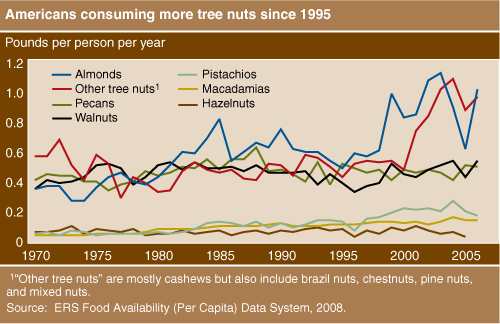Almonds Lead Increase in Tree Nut Consumption
- by Biing-Hwan Lin and Gary Lucier
- 6/1/2008
Americans increased their consumption of tree nuts by 45 percent between the mid-1990s and mid-2000s, with almonds being among the favorites. Promotional programs that advertise the nutritional value of nuts, including beneficial levels of vitamin E and omega fatty acids, have likely contributed to the upswing in per capita nut consumption. The trend toward healthier eating has also played a role, along with the increasing popularity of Mediterranean and Middle Eastern foods that contain nuts. Strong domestic and international demand for U.S.-grown tree nuts has helped keep prices up despite increased production.
The ERS food availability data provide estimates of the food available for consumption and are a proxy for consumption, particularly for understanding trends over time. During 2001-06, nut availability was sufficient to provide each American with an average of 1 pound of almonds per year, 1 pound of “other nuts,” a half pound each of walnuts and pecans, a third of a pound of hazelnuts, and a fifth of a pound of pistachios. “Other nuts” are those that are primarily imported rather than domestically produced and include cashews, brazil nuts, chestnuts, pine nuts, and many nut mixes. Cashews make up the largest share of this category. Actual nut consumption is likely higher because nuts in imported foods are not reported in the availability data.
While nut consumption has generally trended upward since 1995, the annual data for tree nuts show spikes and deep valleys largely because of production cycles. Nut trees are alternate bearing, meaning that they produce a large crop one year followed by a much smaller one the next year as the trees replenish their nutrients. Generally, the cycles bring big swings in crop size. Producers have learned to moderate some of these swings in crop size by increasing planted acreage and yields through improved production and management technologies. To compensate for off-year production, nut companies and major users, such as confectioners and ice cream manufacturers, build inventories during peak bearing years to try to maintain a steady annual supply.
This article is drawn from:
- Food Availability (Per Capita) Data System. (n.d.). U.S. Department of Agriculture, Economic Research Service.
You may also like:
- Fruit and Tree Nuts. (n.d.). U.S. Department of Agriculture, Economic Research Service.


